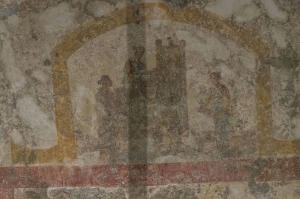Summer. The time of year for slower days, sunshine, summer camps, outdoor adventures, and… the ongoing modesty discourse in certain circles. Matthew Pierce’s April Substack “2024 Summer Swimsuit Guide for Christian Women” is a humorous take on the seemingly endless discussion of appropriate attire for women, with its suggestion of things like force fields and traffic cones as “wholesome, stylish suggestions for swimwear that honors your brothers in Christ.” But all joking aside, the discussion of women’s responsibility to dress in a way that helps men gains new life with each new fashion cycle. And while the specific styles under debate shift each season, with yoga pants, crop tops, swimwear, tank tops, and the length of any summer attire like shorts or dresses making repeat appearances, it seems like the heart of the discourse never really changes. The argument– at least in most of the modern debates about modesty– seems to be about the extent women need to cover themselves in order to avoid causing the men around them to sin by lusting. Are shorts that reach your fingertips protective enough? Or should one simply avoid shorts altogether? What about things like tank tops- how much of a strap is enough? And on and on it goes…
Reading older Christian texts help to challenge the seemingly perennial nature of this modern conversation and its underpinning assumptions. Perhaps much to the surprise of modern Christians, the debate has not always been about women protecting men. Medieval examples of this abound, where sermon tales emphasize the duty of men to help protect sexually voracious women from their desires and penitentials emphasize restraint and avoidance of temptation for both men and women. But today, I want to talk about an example that came up in a recent conversation with my husband Adam Renberg, who studies the early church– the unusual and enigmatic early second century text The Shepherd of Hermas. A simple, widespread, and popular early Christian text, this Greek text is described by scholar Henk Bakker as “almost a genre in its own right, nearly unparalleled,” a series of visions and apocalyptic events that focus on models of penance (Bakker, “Kissing Hermas,” in Early Christian Mystagogy and the Body, edited by Nienke Vos and Paul van Geest, pp. 21-23). Over the course of five visions, twelve mandates, and ten parables, The Shepherd of Hermas engages with questions of conversion, penance, church discipline, communal care, the behavior of the rich and their relationship to the poor within the church, and postbaptismal sin and repentance. Because of its simplicity and widespread circulation (with more surviving early copies of The Shepherd of Hermans than of many canonical writings), the text became a model of communal relations, penance, and conversion for many Christians in the early church.

So what does this have to do with modern modesty debates? It’s worth noting that while The Shepherd of Hermas focuses on sin in the church (with a special emphasis on socioeconomic issues), it explores what it means to truly repent and convert through a series of encounters between Hermas and several women in the text. The first vision focuses on the sin Hermas committed in lusting after a fellow Christian woman, while the second vision focuses on repairing Hermas’s behavior towards his Christian wife. Women consistently appear to Hermas to point out his sins and offer instructions in penance, and women are the key figures involved in building the tower of Christ, a central part of the visions. Believers like Hermas are trimmed and shaped like stones (representing repentance and the cutting away of wealth and passions) before they can be incorporated into the tower of Christ (the church and salvation) by twelve young women who place the stones into the tower and guard against unworthy stones.
At this point in the text, a few things are already clear. First, nowhere in this text are the women around Hermas (the very ones he keeps thinking lustfully about) blamed for Hermas’s actions or thoughts. It is Hermas who is the one who needs to change his actions and thoughts- even when the women he is interacting with are dressed in ways that the text describes as “becoming” (The Shepherd of Hermas, 9.2, p. 623. Translated and edited in Michael W. Holmes, The Apostolic Fathers: Greek Texts and English Translations. Third edition. Baker Academic: 2007). The emphasis in the text is on Hermas’s sins (lust and wealth being the two main ones), and he is repeatedly admonished for judging or questioning the women around him, whether the allegorical ones building the tower or the visions of women from his life that appear to him throughout the text.
Events get even stranger to modern audiences accustomed to purity culture or modesty culture teachings from here, in what Bakker identifies as the heart of the text: the turning point of the ninth parable. In 9.11, Hermas learns (to his great dismay) that the Shepherd, his guide through the penitential journey, is not returning until the next morning, and he is expected to stay the night with the women in the tower, “as a brother and not as a husband.” (The Shepherd of Hermas 9.11, p. 641). Again, the responsibility is not on the women to control Hermas’s thoughts and actions. In fact, the text describes them as greeting him with holy kisses, as singing and dancing, and ultimately as laying down together to pray through the night, all practices meant to mirror different parts of Church life (Bakker “Kissing Hermas” p. 37). Only prayer without ceasing changes Hermas’s heart from its initial lustful and fearful posture towards the women to a posture of brotherhood in Christian fellowship: it is through prayer that Hermas’s heart is changed to a heart of repentance and he is shaped into a stone fit for incorporation in the tower of Christ.
The Shepherd of Hermas contains far more than there’s space to explore here. But I couldn’t help but be struck by the differences in approach between this second-century text and modern online discussions about dress codes, the length of shorts, and the responsibility for the sin of lust. The Shepherd of Hermas uses sexually suggestive language throughout to describe the actions and appearance of the women, but ultimately, the women are blameless: they are simply building the tower, following God’s instructions and seeking to work alongside their brother Hermas. It is Hermas who must be reshaped. It is Hermas who must repent of how he looks at the women– as objects rather than as sisters in Christ– and who needs to take responsibility for his own actions and thoughts. As Bakker states, “the new bond [between men and women] is clearly defined as anti-sexual in content,” and it is the responsibility of the one who is struggling with lust to make it so. Through three distinct encounters with women in the text, Hermas learns that “being close to women should not be an erotic experience” and gains an “awareness of asexual intimacy among brothers and sisters in the faith” (Bakker “Kissing Hermas,” pp. 35, 39). How much of a difference in discussions of modesty, responsibility, and Christian relationships within the church might this shift in perspective make today? If the second century church (in a cultural context in which women were seen as far inferior to men and as objects) could understand that the responsibility for sanctification lies with each believer, why can’t we? As we try to reshape believers into holy stones that build Christ’s church, let’s focus on trimming the stones that have sinful sharp edges to bring them in line with Christ’s commands for a holy life, not on trying to make other stones accommodate their sins. The problem isn’t the swimsuits, but the people who can’t see sisters in Christ wearing them.













